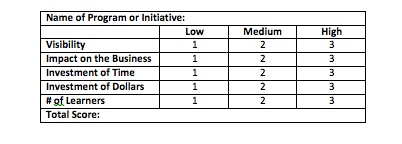
It’s 3 p.m. on a Thursday and 12 trainers are near the end of a certification session on a new program they’ll deliver to 3,000 employees before the end of the year. The trainers feel confident and excited. It’s a great program full of useful skills, entertaining videos, and engaging activities.
Before the session ends, the master trainer asks the group to engage in one final activity. He pulls out a flipchart, grabs a marker, and says, “Let’s imagine you want this program to fail.” The trainers look at one another with raised eyebrows, silently asking if they’ve heard the question correctly. “Come on now,” the instructor says. “What would you do to make sure that participants don’t use the skills they’ll learn in this workshop?” After a long awkward silence, the ideas start to pour out . . .
- “I’d ensure the managers know nothing about the program.”
- “I’d make it a ‘one and done,’ with no refreshers or reinforcement.”
- “I wouldn’t give learners tools they can use back on the job.”
- “I wouldn’t let participants know why they are there or how it relates to them.”
After several minutes, the instructor puts down his marker, looks at the group, and says, “How much of this is actually about to happen when you roll out this program?” The stricken group of trainers realizes they were about to make exactly these mistakes.
Would it surprise you to know this is a real story? In fact, we’ve repeated this exercise dozens of times with seasoned, talented learning professionals and the outcome is almost always the same. Despite the fact that we know better, it is easy to get caught up in the pressure to push out programs quickly and neglect the factors that will dictate whether the learning will improve performance.
What to Focus On
These six best practices dramatically increase the likelihood that what is learned in the classroom makes a difference in job performance:
- Link to Business Strategy
- Gain Executive Sponsorship
- Create a Communication Plan
- Integrate Expectations, Processes, and Tools
- Prepare Managers
- Drive Coaching and Reinforcement
Why These Best Practices?
Here’s why each practice is important.
Link to Business Strategy
Training initiatives that originate from business strategy become a priority for everyone in the organization. These initiatives capture and hold the attention of executives, managers, and the learning audience. A powerful link to business strategy helps learners and managers understand the importance of the initiative. If the link is missing, business as usual takes over and executive attention wanes, managers manage the way they already manage, and learners have little motivation to try new behaviors.
Without a link to business strategy, learners and managers will believe it is not important.
Executive Sponsorship
Active sponsorship from the top of the organization and/or the business unit has a direct impact on participation, commitment, and application of learning to the job. When “the boss is driving the bus,” others quickly jump on board and the likelihood of sustained behavior change increases significantly. Without ongoing executive sponsorship, learners and managers perceive training as a distraction from their immediate work objectives.
Without executive sponsorship, learners and managers will believe it is not a priority.
Communication Plan
The most successful learning leaders make sure that everyone affected knows what’s coming, how it supports the strategy, what’s in it for them, and exactly what role they are expected to play—both before and after the core learning takes place. When linkages and expectations are consistently communicated, learner motivation and manager commitment to coaching and reinforcement dramatically increase. Without communication, people show up for programs and passively participate without knowing what’s at stake.
Without a communication plan, learners and managers won’t understand the initiative.
Expectations, Processes, and Tools
For learning to translate to real-world application, the concepts, skills, and behaviors must be integrated into day-to-day work processes. Let learners know they will be coached, supported, and managed as they try new behaviors when they go back to the job. Build job aids, checklists, and other tools. Don’t leave it up to each learner to figure out what to do differently back on the job. Form a pilot group or team of high performers to create and beta test plans and processes for ensuring new skills become part of the workflow. Skipping this best practice guarantees learners will revert to old habits and patterns.
Without expectations, processes, and tools, learners won’t apply new skills to their jobs.
Manager Preparation
Manager involvement has a greater impact on ensuring the application of learning than any other factor. In order to recognize, reinforce, and/or redirect behaviors, managers must know how to coach on the specific skills their people will learn. Sidestepping manager preparation means managers won’t be equipped for their role—a huge loss when you consider what research shows about the power of manager coaching.
Without manager preparation, managers won’t be ready and able to coach.
Coaching and Reinforcement
Many programs include reinforcement components and coaching tools. While these tools are a great start, be clear about when and how these tools get used. Coach the coaches. Develop concrete coaching plans and accountabilities and ensure managers and/or champions are following through with coaching, conducting best practice sharing meetings, and leading application sessions. Without this step, new skills won’t get used and new behaviors won’t be sustained—and you won’t see the business impact you need.
One study showed that after managers were trained in coaching skills, the average performance of direct reports improved 18 percent. However, when managers were trained on both general coaching skills and how to coach to the specific skills their employees were learning, performance improved 42 percent—or two and a half times more than with coaching skills alone.
Without coaching and reinforcement, new skills and behaviors won’t be used and sustained.
Addressing Resistance to the Best Practices
None of these best practices are trade secrets. Most training professionals can generate a similar list from their own experiences. So why do we so often avoid doing what we know we should do? The reasons for not using these practices are as familiar as the practices themselves: “It’s too hard . . . I don’t have the budget . . . I don’t have time.” Maybe a more productive question is to ask, “When do we take a stand for including the best practices?’’
To help you decide where to invest your time, rank your projects in terms of how each compares to other projects your team or department is working on this year—the higher the score, the higher the stakes. The higher the stakes, the more you can make the case that you can’t afford to risk the consequences that come with neglecting the best practices.

Create an Implementation Team
These six best practices remind us what to do. There are many different ways to accomplish the how.
The key is to choose actions and activities that work within your own organization and are aligned with the importance and visibility of your initiative. You might bring training designers and facilitators together with a sampling of the learners’ managers and other stakeholders. Ask the team to brainstorm possible actions and activities in support of the best practices, and then sort and select the activities that will have the greatest possible impact. Assign a person to execute each action so the strategy becomes a reality.
As a client recently said, “In the past we used to focus on what happened in the event. Now we turn it on its head and ask, ‘What will it take to achieve the performance outcomes we want?’”
You wouldn’t roll out a training program without scheduling a classroom, inviting participants, and ordering materials. Make the strategic side of implementation just as automatic by incorporating as many of these best practices as you can. Can you leverage the best practices in this article or perhaps come up with some of your own? Can you carve out some time when planning your important initiatives to stop and ask, “If we want this learning to get used back on the job, what will it take?”
Given that neglecting the best practices can sabotage your efforts, can you afford not to make these six best practices a priority?
Wendy Mack is director of Consulting Services for Wilson Learning Corporation. Mack leads the team that is responsible for diagnosing client needs and designing comprehensive solutions that result in sustained behavior change and performance improvement. Mack’s work blends her expertise in learning and development with her extensive knowledge of human performance technology, change management, and communication. She has more than 20 years of experience in the individual and organizational development arenas and has co-authored three books on the topics of learning, leadership, and change. For more information, contact Wilson Learning at www.WilsonLearning.com or 800.328.7937.




